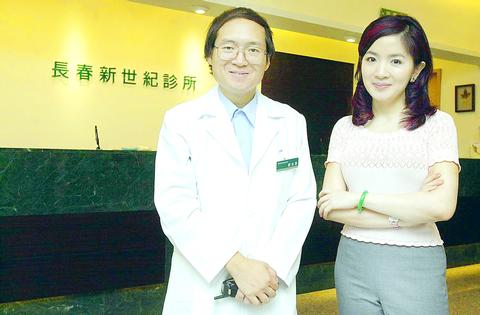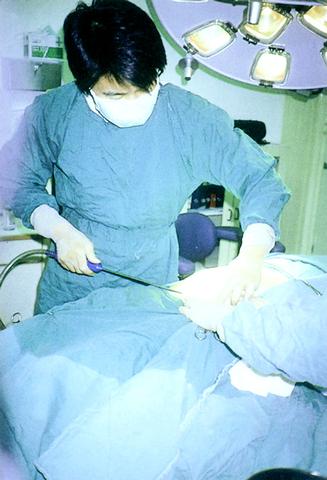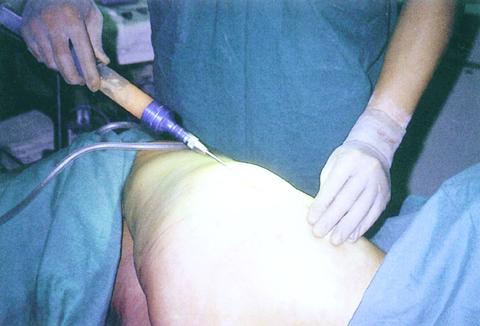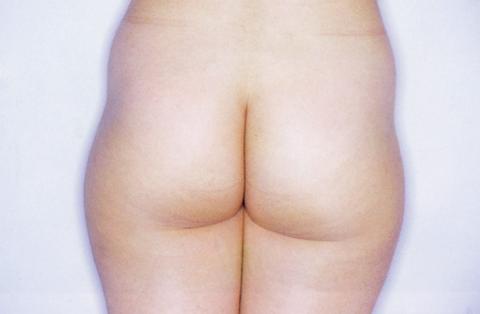Joey Lin remembers well the first time she visited Long Spring Hospital (

PHOTO: CHIANG YING-YING, TAIPEI TIMES
Told to come early, she arrived at the clinic at about 6am, and got into the line that was already long and growing rapidly. A chartered bus, carrying dozens of patients from Kaohsiung and other areas of southern Taiwan had arrived long before, the passengers already milling about outside in the early morning light.

PHOTO: CHIANG YING-YING, TAIPEI TIMES
"Hey Miss, line up at the back. Don't cut in!" some of the ladies said.
The clinic wouldn't open for another three and a half hours. This line was just for patients to get a number for registration later at the hospital.

PHOTO: COURTESY OF TSAI REN-YU
Lin would later realize that it's common to wait in line at the clinic for four to five hours along with the more than 100 people who typically jam the 30m2 clinic at all times of the day.

PHOTO: COURTESY OF TSAI REN-YU
Handling the non-stop flow of patients are Dr Liu Bo-en (
"When it gets busy, the nurses don't have time to take your registration. You don't know where to get the medicine after seeing the doctor. And the phone keeps ringing without anyone answering. People start talking really loudly out of boredom and long waiting. It gets really messy," Lin said.

PHOTO: COURTESY OF TSAI REN-YU
Welcome to the crazy world of weight-reduction in Taiwan, where many women view Liu as nothing less than a miracle worker.

PHOTO: COURTESY OF TSAI REN-YU
Having wised up after several visits, Lin learned to get to the clinic in the morning, take her registration number and then go to work. When she returned after work in the evening, her number would be about up. A visit would involve a basic health checkup and then a two-minute consultation with the doctor. Then, because there are so many patients, she would have to return the next day to pick up the medicine she originally came to get.
"Every time I go, there are always fights between patients over who was first, or why some can't get the medicine early ? things like that. Some people even pay delivery service couriers to stand in line for them, while others wave legislators' business cards as a way to cut in line."
"Were it not for the medicine being so effective, I would never want to queue up like this," Lin said. For one week's regimen, the medicine costs about NT$1,500, and in the first week helped her shed 2kg. She gave up the treatment after two weeks, however, feeling put off by the madhouse at the clinic.
New Bodies
What the patients are raving about is Lin's weight-reduction treatment, called the Cocktail Obesity Treatment (
Originally a gynecologist and a surgeon, Liu switched his specialization to weight reduction treatment 18 years ago and by his own estimates, he has treated between 300,000 to 400,000 people.
The so-called cocktail treatment is a combination of medicine, diet-control and exercise, tailored to an individual's physique and condition. Its effectiveness lies in the unique combinations of
prescriptions. "I have more than 400 kinds of secret prescriptions, which I can use for many more variations," Liu said proudly.
He explains that obesity in Asian people is different from that of, say, Caucasians. "Although fat is a major reason behind obesity, obesity in Chinese people is more due to the starch-heavy diet from their staple food -- rice," Liu said.
According to him, this is why the weight-control pill Xenical, wildly popular in the West, has little market share in Taiwan.
Having published three best-selling books and recently opened a second clinic, a much larger, cleaner and better-designed hospital called Long Spring New Century Hospital (長春新世紀醫院), Liu's weight-reduction business has seen exceptional growth.
He has even developed a sophisticated sales pitch. On his clinic's TV advertisement, which gets heavy rotation on cable TV, the center appears more like a beauty salon with shiny machines and massage therapy. A voice-over by Liu has him saying: "This is the coming of a new century. We call it tailor-made body sculpting ..." Body sculpting is a national movement, Liu says.
Thinner and thinner
By all indications, the weight reduction or body sculpting business is a high-growth sector in Taiwan and its consumers are predominantly women.
Body, a magazine specifically about weight control and body sculpting, was founded five years ago and has seen its circulation double in the past four years, according to its deputy editor in chief Serena Lin (
"Our magazine targets 20- to 30-year-old women. But the majority subscriber group is always between 18 to 25. And recently we have a lot of junior high school subscribers, even including a 10-year-old girl," Serena Lin said.
She said young women's ideas about weight-control are focused on being "thinner and thinner," to the point of being slimmer than standard weight, and that body sculpting is much more emphasized.
This obsession is vividly illustrated in 27-year-old Helen Lee's body sculpting quest. An attractive executive in a financial company, Lee is 160cm tall and weighs 48kg and has spent hundreds of thousands of NT dollars on her body since she was 20.
Though she has never weighed over 53kg, which is a standard weight for a woman her height, she has always had complexes about her body. "I've always thought my body was imperfect and I wanted to make it perfect," she said. "Especially the hips, you know. We Chinese always have hips that are too wide and flat," Lee said.
In college Lee joined an aerobics center. Later, she bought several body-sculpting sessions at Famous (
She said she has bought all kinds of weight loss products, some from TV infomercials, others from famous and expensive brands like Christian Dior and Lancome.
A year ago, Lee put down NT$50,000 for liposuction surgery on her hip and belly. Now, seven years and NT$300,000 later, she said she is "finally a bit satisfied."
"I've done all of this for myself, not for any man or my boyfriend, who doesn't even know about the liposuction. Only lazy people cannot make themselves thinner and prettier," she said.
Back in Liu's new Long Spring hospital in central Taipei, there are more women like Helen Lee, who have a nice figure, are of standard weight, but still seek help in losing weight.
At the new clinic prices are much higher than at the old one. Registration is NT$200, the general checkup is NT$2,500, plus another NT$2,500 for the medicine. If anything unites the women at the clinic, it is that they appear well-off and fashionable. Few are overweight.
The clinic is a virtual congregation spot for celebrities, and Amy Ho (
What women really want
Liu, who takes patients night and day, sees his mission as helping women fulfill their dreams to attain a perfect body.
"A lot of women come for treatment because their husbands are having affairs. They want to be slimmer to save their marriage. I also have patients who said I have to make their boring lives more colorful," Liu said.
Liu faults modern medicine for neglecting the needs and feelings of women, and cites this as his reason for switching his specialization from gynecology to treatment of what he calls "morbid obesity."
But the government is not particularly enthusiastic about Liu's vocation to "help" women achieve the "perfect" body.
Chen Shu-kung (
"Some of the medicines used in the treatment were not developed for the purpose of weight-control. So it is doubtful whether it's appropriate or legal to prescribe the medicine," Chen said.
Liu and Ho are unfazed. They see themselves as pioneers in their field and together they have formed Long Spring Biotech Corp to develop new medicines and health foods. His "cocktail medicine" is now available on the general market in Taiwan -- labeled as a health food, not as medicine -- and will be distributed in Hong Kong and Singapore next month.
"In the future, we will unveil products from our new research, like slim water, slim instant noodles, all with an eye on the Asian and China market" Liu said. From the crowds outside his clinics, clearly many Taiwanese women are cheering Liu on.

The canonical shot of an East Asian city is a night skyline studded with towering apartment and office buildings, bright with neon and plastic signage, a landscape of energy and modernity. Another classic image is the same city seen from above, in which identical apartment towers march across the city, spilling out over nearby geography, like stylized soldiers colonizing new territory in a board game. Densely populated dynamic conurbations of money, technological innovation and convenience, it is hard to see the cities of East Asia as what they truly are: necropolises. Why is this? The East Asian development model, with

June 16 to June 22 The following flyer appeared on the streets of Hsinchu on June 12, 1895: “Taipei has already fallen to the Japanese barbarians, who have brought great misery to our land and people. We heard that the Japanese occupiers will tax our gardens, our houses, our bodies, and even our chickens, dogs, cows and pigs. They wear their hair wild, carve their teeth, tattoo their foreheads, wear strange clothes and speak a strange language. How can we be ruled by such people?” Posted by civilian militia leader Wu Tang-hsing (吳湯興), it was a call to arms to retake

Desperate dads meet in car parks to exchange packets; exhausted parents slip it into their kids’ drinks; families wait months for prescriptions buy it “off label.” But is it worth the risk? “The first time I gave him a gummy, I thought, ‘Oh my God, have I killed him?’ He just passed out in front of the TV. That never happens.” Jen remembers giving her son, David, six, melatonin to help him sleep. She got them from a friend, a pediatrician who gave them to her own child. “It was sort of hilarious. She had half a tub of gummies,

The wide-screen spectacle of Formula One gets a gleaming, rip-roaring workout in Joseph Kosinski’s F1, a fine-tuned machine of a movie that, in its most riveting racing scenes, approaches a kind of high-speed splendor. Kosinski, who last endeavored to put moviegoers in the seat of a fighter jet in Top Gun: Maverick, has moved to the open cockpits of Formula One with much the same affection, if not outright need, for speed. A lot of the same team is back. Jerry Bruckheimer produces. Ehren Kruger, a co-writer on Maverick, takes sole credit here. Hans Zimmer, a co-composer previously, supplies the thumping